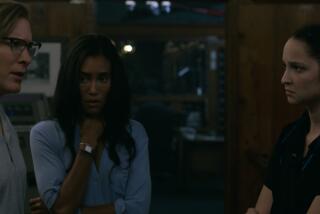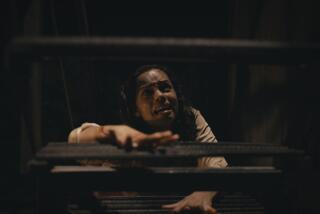Shakira in pause mode
Shakira was sick of being a celebrity. Colombia’s sensationally successful singer-songwriter had just come off her “Oral Fixation” tour earlier this year, taking her to 140 cities on five continents to perform for 2.5 million fans. But even stardom can be a drag.
So she put away her revealing sequined gowns and hip-hugging pants, donned jeans and sneakers, tucked her famous shock of dyed hair under a cap and went undercover as a summer student at UCLA. She enrolled in a history of Western civilization course under her middle and last names, Isabel Mebarak, telling clueless classmates she was just visiting from Colombia.
“Oh, it was such a respite for me,” Shakira recalls. “I felt that need to put a brake on everything, to escape from the celebrity life and reclaim a normal life for a while. It was very healthy for me.”
Her decompression from rock star to common coed was not just therapeutic, it coincided with the creative retreat she required to compose new songs for the film “Love in the Time of Cholera,” which opened Friday. This is the first time she has written music for a movie, a challenge she assumed in honor of her compatriot, mentor and “dear friend,” Gabriel Garcia Marquez, the Nobel laureate whose novel of love and irrational devotion is the basis for the movie.
The work marks a radical departure for Shakira, from flashy, electrified pop/rock to gentle, acoustic, Latin American folk styles. The songs -- a bolero and a traditional Andean tune -- are almost period pieces, tailored to the film’s genteel setting in Cartagena circa 1900.
Shakira is arguably the most successful bicultural star Latin America has produced, and she’s always been adept at straddling both English- and Spanish-speaking worlds with her seductive pop fusion that draws also on her Middle Eastern heritage. But these songs required her to tap into deep cultural roots, to reconnect with the music she was raised on in Barranquilla, music that still makes her cry and that instantly touches her soul, like a memory.
“It was refreshing, because it allowed me to leave the pop universe for a moment and not think about the Top 10 on the radio, and not think about . . . .” She pauses. “And simply not think. To just let the sensibility flow from those stories, let those Garcia Marquez metaphors connect with the deepest part of me, and allow the music to be born form all of that.”
She is speaking in Spanish in the pastoral, equally genteel setting of a patio restaurant at the Bel Air Hotel. She looks relaxed and casual, wearing a tank top and jeans, her hair loose and a bit disheveled, showing dark roots under a dyed, reddish brown crown. She accentuates the color contrast by fidgeting with a long naturally dark strand that she pulls down along her neck and twirls at her shoulder.
Without much makeup, she looks more like that average girl in history class than a sultry superstar. Now 30, she appears somehow younger than when I first met her in 2001 on the eve of releasing her first English-language album, “Laundry Service,” a smash that launched her global career. At that time, everything about her seemed more calculated -- her appearance, her poses, her wardrobe, her answers. Today, Shakira doesn’t have much more to prove, so she can let her hair down, somewhat. When her handler signaled that time was up after only 20 minutes, she whispered conspiratorially with a coquettish chuckle, “We’ll just steal a few more minutes.” Then she went on to talk for an hour.
Colombia’s image
Shakira, who writes her own songs in Spanish and English, speaks at times as if she’s writing out sentences in long hand, like the character of Florentino Ariza (Javier Bardem) writing his first love letter to the woman for whom he’d wait half a century, Fermina Urbino (Giovanna Mezzogiorno). It’s as if she has an automatic editor in her brain, scanning for the right words, selecting, deleting, selecting again.
When she talks about Colombia, she taps into a florid Castilian that flows in long passages, like the novel, which she calls “one of the last great love stories of our time.” The film’s cool reviews seem beside the point in light of her passion for it as a vehicle to provide a positive image of her country, one not of guerrillas and drug lords but of “starry nights and long silences by the sea.” “That is the Colombia I wanted to share,” she says, “and for that I felt it was a privilege to be involved in this project.”
Garcia Marquez himself urged Shakira to take an acting role in the movie, she says, but other commitments forced her to turn down what would have been her acting debut. Producer Scott Steindorff, however, reveals another reason for her decision. The role would have required some nudity, he says, and Shakira was reluctant to do that. Shakira says she’s received many acting offers over the years, but the right one hasn’t come along. That’s going to be harder than finding true love, since she imposes tough preconditions. “The script, the character, the director, it all has to come together to assure me that I’ll be protected, because I have an image . . . .” She pauses again to correct herself. “I have a responsibility to my public, so I don’t want to get into something that could fail.”
That’s the notorious control freak who micromanages every aspect of her career, down to every frame of her videos. “I control totally,” she acknowledges, with a forced laugh that hints at insecurity. “So I need to put my [acting] career in the hands of the right person, including the right acting coach because I’m not sure what my thespian skills [destrezas histrionicas] may be. It’s something that remains to be discovered.”
On the other hand, she had no doubt about her ability to write the songs for this film. The music came to her spontaneously after she saw a rough cut in London. When it was over, she turned to British director Mike Newell, and hummed a melody for him.
She repeats the tune in a low sensual voice that fluctuates dramatically with melisma and falsetto: “Ay, mi bien, ta-ri-ri-da-da-ra, la-di di da di di da. . . . And it just started to come out of me like that, a spontaneous reaction. So I felt it was my duty, almost a moral one, to be involved with this project.”
‘In my blood’
That snippet turned into “Hay Amores,” a bolero full of romance, poetry and yearning. It’s a style that dates to the late 1800s, matching the movie’s era, and was popularized throughout Latin America in the 1940s and ‘50s by guitar trios such as Los Panchos and Los Tres Reyes, whose surviving member was invited to play on the recording, available on iTunes and soon on the soundtrack.
“The bolero is in my blood,” says Shakira. “And it’s undoubtedly the pinnacle of romantic music. Nothing can capture the sentiment of love like a bolero does, and nothing else could do justice to this story.”
The other original song, “Despedida,” is written in a folkloric style evoking the mournful sound of Andean music, with native instruments such as the bombo, a drum, and the charango, a small guitar. Shakira calls it “the song of her dreams” because she had always wanted to write something that evoked “the lament of the Andes.”
“The curious thing is that this is a song of farewell, of death, of loss, but at the same time, it was a pleasure to do,” she says. “Digging into this new world of folklore was definitely one of the greatest challenges for me.”
Donated royalties
She was joined in the effort by influential Argentine musician Pedro Aznar as co-producer, along with Brazil’s Antonio Pinto, who co-wrote the songs and the original score. All royalties from songs in the movie, including “Pienso En Ti” which she wrote at age 17, will go to Pies Descalzos (Barefoot Foundation), her nonprofit aimed at helping children who are victims of violence in Colombia.
Shakira worries that Latin America’s traditional music represents a dying art on the continent, and delights at the suggestion of making a full album in the same style. But aside from the release this week of a DVD with concert and documentary footage, she has no plans for a new record.
Soon, she is joined by her fiance, Antonio de la Rua, a shaggy-haired lawyer who’s the son of a former Argentine president. Their steady relationship dates to the beginning of this century, before her fabulous ascent. They’ve lived through a lot of changes, she says, and surmounted their share of obstacles, but they’ve grown as individuals and “we’re still together, still hand in hand.”
So does she believe in that old-fashioned concept of courtly, long-term love as portrayed in the movie? Is such romance relevant in a world of instant gratification, and how does she reconcile that with the raw rock culture she’s embraced?
For the first time, Shakira appears to be at a loss for words. “Excuse me,” she says, twirling her coffee cup in its saucer while composing her thoughts. “Love has always been full of patience, hasn’t it? And patience is the privilege of those who truly love, right? Yes, it’s difficult to imagine a Florentino Ariza today in 2007, but I’m an optimist. I believe that in all of us, in every man and woman, there is a Florentino and a Fermina, perhaps willing to wait, to transcend the obstacles of space and time, for the love of one’s life.”
--
More to Read
Only good movies
Get the Indie Focus newsletter, Mark Olsen's weekly guide to the world of cinema.
You may occasionally receive promotional content from the Los Angeles Times.






